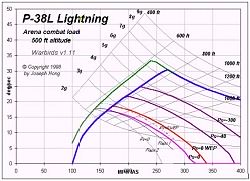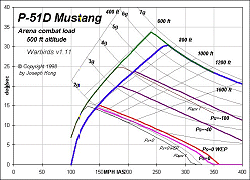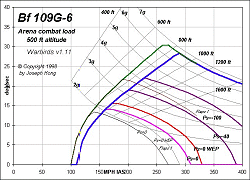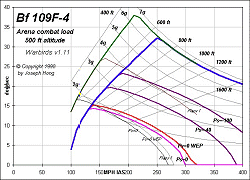| Using E-M Charts by Joseph Hong |
||||
|
The previous article on Energy-Maneuverability (EM) charts explained only the meaning of the individual lines on the diagrams. Now we'll discuss how to compare the performance of different fighters using the charts and how to take advantage of the information presented. To exaggerate the differences in aircraft performance, let's take a turn fighter and an energy fighter's charts. We'll use the previous P-38L chart and compare it with the P-51D chart. Our starting point is each aircraft's best Sustained Turn point: the P-38L can sustain a flat turn using WEP and one notch of flaps at an indicated airspeed of 160 mph, while the P-51D with WEP (and no flaps) flies at 150 mph ias. At the sustained turn point, the P-38 turns at 19° per second while the P-51 does only 15°/s. This illustrates the P-51's weakness in turning, but is rather meaningless. In a dogfight each plane will use higher rates of turn to gain or deny advantage, despite the loss of energy this incurs. The P-38 is more apt to use a diving turn with one notch of flaps and full power only. This is represented by the Ps=-100 line, giving an ias of 200 mph, a G-load of 4.5 Gs, and a good turn rate of 26°/s. If the P-38 were to try a flat turn at this G-load, it would bleed away its speed instead. The dive of 100 feet per second allows it to exchange altitude in order to maintain speed (and thus turn rate). The P-51 can attempt to do the same diving turn (flaps 1, full power) at 190 mph and 4 Gs to produce 25°/s for the same energy loss. So, by burning up some energy (in the form of altitude), an energy fighter like the P-51 can in fact turn with a stall fighter like the P-38, but only until altitude runs out. We now extend this to analysis of Corner Velocity. With flaps 1, full power, and a 6.67 G load, a P-38 at 240 mph can do 33°/s. The P-51 at 240 mph can hit 34°/s, surpassing the P-38 for the briefest of moments! But here we see something very interesting: the distance from the Ps=-100 line to the lift limit line shows how severe the energy loss is for the maximum instantaneous turn. The gap between these lines is in fact smaller for the P-38 than the P-51! This means that the P-38 is more energy efficient during max instantaneous turns than the P-51. While this is surprising, it is quite logical for turn fighters to be more energy-efficient in hard turns. This is why they can sustain better turn rates. |
And this is why it doesn't pay for an energy fighter like the Mustang to Turn and Burn with a turn fighter like the Lightning. The charts clearly show that the P-38 is a superior turning aircraft versus the P-51. Their turn performance envelopes are identical, but the energy contours determine the advantage of the P-38. But, yeah, we all knew that. The question is, can we use this chart to see how the Energy Fighter can defeat the Turn Fighter? The answer lies in using one's strengths to defeat the other's weaknesses. Observe the lines of constant excess power (Ps) in each chart. In the P-51 chart, its Ps contours are straight and do not fall off quickly at higher speeds. For the P-38, the Ps lines curve down quickly beyond 300 mph. This means a P-51 retains energy better in a turn with moderate G and very high speed (3 Gs at 350 mph). Any P-38 attempting to keep up will lose speed very quickly. The P-38 chart shows that it is most effective within the speed range of 150 to 270 mph. In the regime of 200-270 mph it can perform energy-efficient hard turns. Turning with a P-38 at this speed is therefore a mistake. Its speed must be bled away further with techniques such as Boom and Zoom. When the P-38's speed drops to 170 mph and below, it can't pull hard turns any more. If the energy fighter has kept its speed up, this is the moment of advantage. The P-51 turns quite well between the speeds of 180 and 270 mph, especially with combat flaps. Using the P-51's good instantaneous turn at these speeds allows it to make some kills. It pays for this with a substantial energy cost, but that should be acceptable since it doesn't have a good sustained turn anyway. As an exercise, let's now compare the P-51D versus the Bf.109G-6. The chart of the Bf.109 shows a less capable turn performance envelope than the P-51. However, with WEP it can hold a sustained turn at a slightly better rate. Between the speeds of 200 and 300 mph, the energy contours of both planes at full power are quite similar. If the Bf.109 employs WEP between 200 and 300 mph, it can suck the P-51 into a sustained turn fight where the German aircraft has a slight, but lethal, advantage. The charts indicate that the P-51 using combat flaps in a max diving turn should be able to out-turn the Bf.109, but this really needs to be verified with your favorite WWII air combat simulation.
|
|||
|
© 1997 - 2000 COMBATSIM.COM, INC. All Rights Reserved. Last Updated November 18th, 1998 |
||||




